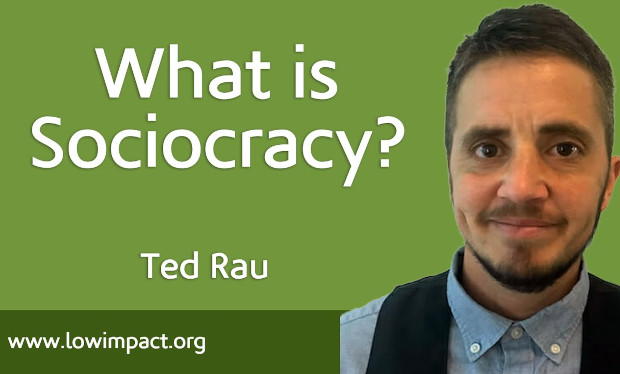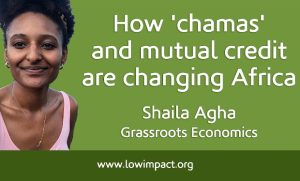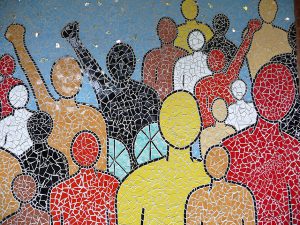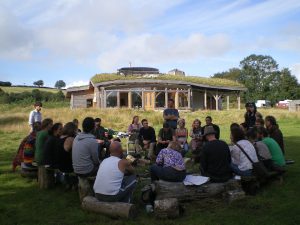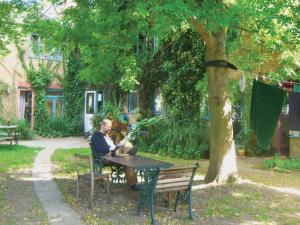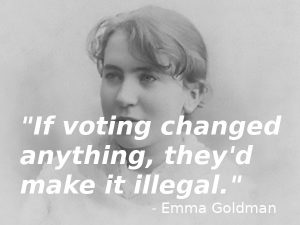Here I’m talking with Ted Rau, one of the co-founders of of Sociocracy For All, and leader of the general circle for that organisation.
Hello Ted. I want to interview you to produce an introduction to sociocracy for Lowimpact.org, and to promote the concept of sociocracy, and your organisation. I work with 2 co-operative, non-hierarchical groups – the Credit Commons Society and Lowimpact.org – and in both organisations, we’re looking into sociocratic decision-making.
There’s more detailed information on your site, which I’ll link to, but this is just an intro, to inspire people to find out more.
First – what’s it for – what problem does it solve?
Sociocracy is a governance system – which doesn’t sound super-exciting to a lot of people at first. I understand governance as the piece that connects the people and the project they want to do. If you get 50 or 100 people who want to do a project, and put them all together in a room, probably not very much is going to happen. You need the ‘wiring’, the ‘plumbing’ – the structures and procedures between the people to make it all happen. That’s what governance is. There are 2 parts to it – first, who decides what / does what; and the second part is how we decide. Those are the two things that sociocracy answers.
How does it work? What’s the basic idea?
The basic idea is to create small groups, so that we can always have good, deep, meaningful conversations – in order to collect feedback and learning from all over the organisation. Everything that needs to be decided is split into pieces and distributed into what we call ‘circles’. So for example, in a medium-sized organisation, you might have 20 circles, that each has a clear area of decision-making – so that everything has a ‘box’ where it can be decided. Ideally, those circles will contain between 4 and 7 people – small groups that can really listen to each other. That way, there’s a place where everything can be decided, and you have groups that are empowered to make those decisions, so that then, the people really are in charge. The people who make the decisions in a circle are the people who do the work that is covered by the decisions made in that circle – unlike in a hierarchical system, where some people do things and some people decide things.
What’s the process?
There are several processes. The decision-making process is by consent, which means that a proposal passes if no-one in the decision-making group has an objection. If no-one thinks that the proposal will harm the group (and shows how it will do that), then the proposal is adopted.
I used to live in an intentional community, with 15 members. We had a weekly meeting, and we used consensus decision-making. So it was more than consent – everyone had to positively agree before a proposal was accepted. Consent is quite different to that, isn’t it?
Yes, because you don’t have to actively agree – to think that it’s the best idea. You only have to be able to live with it. A slogan in sociocracy is ‘safe enough for now, good enough to try’. You don’t have to be super-enthusiastic, because the difference between loving an idea and thinking it’s just fine might not be that big in practice. Also, ultimately, none of us knows what’s going to happen. We’re all making guesses about the future, and really, the best indicator of whether something is going to work is to try it out and to see what happens. So consent aims to lower the bar a little bit, so that we can do something and learn from it, instead of staying in our heads, in a hypothetical situation, looking for the best plan, without actually doing anything.
‘The best is the enemy of the good’.
Exactly.
A bit of history?
Sociocracy was put together by somebody called Gerard Endenburg in the Netherlands in the 1970s. He was drawing on his experience of going to a Quaker school as a child – where consensus decision-making is used. He was also an engineer, and studied cybernetics. He learned about feedback, which is what we’re talking about in sociocracy – we try things out and learn from that. He was also fascinated by natural systems – especially ‘nesting’, in which everything has a ‘part of’ relationship with other elements of the system. This is reflected in the circles, with their sub-circles. So for example the marketing circle of an organisation might have a social media sub-circle, which might have a Twitter sub-circle, and so on – in the same way that in nature, a leaf is part of a branch, which is part of a tree, which is part of a forest etc. He tried this out in his own company.
Now, every person who learns sociocracy makes it their own, with little changes and new flavours.
What different kinds of sociocracy are there? Are there different styles for different kinds of organisations or circumstances?
It always gets adapted in practice. People produce their own flavours, name them and put out their own version. Gerard Endenburg’s version is called the Sociocratic Circle Method, which has its own set of rules and methods. Then there’s Sociocracy 3.0, which is an attempt to make it more suitable for businesses, especially those using Agile sytems.
What happened to Sociocracy 2.0?
There isn’t one. I’m not sure why. But the intention was to honour the legacy of sociocracy, but to take it forward into something new, because of that connection to Agile. It takes the basic sociocracy idea, and puts it into different patterns, which I have mixed feelings about, but the idea is that people can just mix and match the different pieces.
Another spin-off is holacracy, which is used a lot in for-profits.
I’ve heard about holacracy. What’s the difference between sociocracy and holacracy?
OK, so this is going to be an over-simplification, but overall, holacracy puts more emphasis on roles than on circles. This means in practice that in sociocracy, decisions are made more collectively, whereas in holacracy, the emphasis on roles means that more authority can be clustered in individuals. It’s a little bit more individualistic, with authority embodied within people. You can define operational roles in sociocracy too, as much as you want to, but holacracy really builds on that. Another difference is that holacracy is stricter in the decision-making, in that there’s a filter mechanism for objections. In sociocracy you have more leeway to explain an objection in whatever way you want, but in holacracy you have to match a pattern. Only then will the objection be heard.
How widespread is sociocracy? How much has it taken off?
The thing about sociocracy is that it’s a free and open system, so that no-one has to tell anybody if they use sociocracy; they don’t have to license it etc. People can just do it, or do parts of it – which I love. So it’s been used for many years now in intentional communities. In the intentional community where I live, we’ve been using it for 9 years.
You live in an intentional community? Which one?
Pioneer Valley Cohousing in Amherst, Massachussetts. 32 houses, about 80 people. There are lots of intentional communities using sociocracy. If you look on the website of the Foundation for Intentional Community, there are around 200 communities that self-identify as sociocratic. That doesn’t necessarily mean that they use sociocracy in the way that I describe it – but it really is out there in the intentional community world.
In other sectors it’s up and coming, like worker co-operatives.
There’s a lot of information about sociocracy on the Co-operatives UK website.
Great. And then there are also schools, non-profits and for-profits too, where it’s lagging behind a bit, but there’s an increasing demand for and interest in sociocracy – especially in the last 5 years.
What’s your role in Sociocracy For All?
I’m one of the co-founders, and I’m currently leader of the general circle – and for the next 9 months, when we’ll have a selection process again. So where all the nested circles come together – the ‘tree trunk’ if you like – that’s the general circle. I was selected as the leader of the general circle, so I’m the counterpart of the executive director.
Does that mean that your voice has more weight in the general circle?
No, because we make decisions by consent. However, I work full-time, I contribute a lot, and so I know a lot about the things that are happening. I’m one of the people who can connect loose ends that haven’t found each other yet; and there’s some power in that, because there’s power in doing things. Another way that I have power, which I have a lot of mixed feelings about, is that I have a lot of experience, and a lot of my colleagues are younger, and don’t have as much experience, so they look up to me. We’ve started to have conversations about this – about succession – because I don’t want to just sit in this role until I retire. That’s not my plan – I want other people to step up, and to gain experience.

